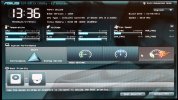Bizarre issue here which is becoming more of a nuisance than anything else. Couple of upfront points:
1) Motherboard is at the latest BIOS
2) SSD's are at the latest F/W
3) Model is Asus P8Z68 Pro-V
4) Its a UEFI BIOS.
5) I have a second 128Gb Vertex which is used for Apps', Games and such (not bootable)
6) I have 2 x 1TB RAID drives I use as a dumping partition for downloads etc.
I had a 60Gb Agility 3 installed in my system as the primary boot drive, no problems at all, take an image every week as a backup, so on so forth.
I went to upgrade to Windows 8, but naturally not having enough disk space meant either a fresh install (pain in the proverbial for me) or simply upgrade the disk. I chose to upgrade and bought a 128Gb Vertex4.
Gets it delivered installs it into the system as a secondary drive, checks the bios can see it, boots into windows, formats it and then proceeds to clone Agility > Vertex. Straight forwards...... you would think...
Powers the system off, removes the agility from Port P0, moves the vertex over to Port P0 and then boots into the BIOS to change/ensure the boot drive is set.
No drive is showing in the list for bootable devices, yet the drive is actually showing under the SATA interface and is detected *scratches head*. After a bit of fiddling changes the bios over to EZ mode rather than advanced, chooses a boot device and hey presto it's listed and the drive boots into windows no problem....but only if i manually choose it each time.
If i leave the system to boot on it's own, i simply get a no BOOTMGR message. I have to go into the bios each time change it to EZ mode and select the boot device.
I tried to put the old drive back in and I get the exact same issue?? Nothing has changed. I even changed the BIOS to Legacy mode.
I've tried to repair windows, it doesn't work. however if I remove all the other drives from my system it boots, but i still can't set it as a bootable device in the bios.
I even tried to upgrade to windows 8, goes through the process and fails.
I've tried bootrec to no avail also.
Everything points to the BIOS, but then doing a few searches it's an issue with Windows 7 and SSDs, but there doesn't appear to be any clear resolution.
1) Motherboard is at the latest BIOS
2) SSD's are at the latest F/W
3) Model is Asus P8Z68 Pro-V
4) Its a UEFI BIOS.
5) I have a second 128Gb Vertex which is used for Apps', Games and such (not bootable)
6) I have 2 x 1TB RAID drives I use as a dumping partition for downloads etc.
I had a 60Gb Agility 3 installed in my system as the primary boot drive, no problems at all, take an image every week as a backup, so on so forth.
I went to upgrade to Windows 8, but naturally not having enough disk space meant either a fresh install (pain in the proverbial for me) or simply upgrade the disk. I chose to upgrade and bought a 128Gb Vertex4.
Gets it delivered installs it into the system as a secondary drive, checks the bios can see it, boots into windows, formats it and then proceeds to clone Agility > Vertex. Straight forwards...... you would think...
Powers the system off, removes the agility from Port P0, moves the vertex over to Port P0 and then boots into the BIOS to change/ensure the boot drive is set.
No drive is showing in the list for bootable devices, yet the drive is actually showing under the SATA interface and is detected *scratches head*. After a bit of fiddling changes the bios over to EZ mode rather than advanced, chooses a boot device and hey presto it's listed and the drive boots into windows no problem....but only if i manually choose it each time.
If i leave the system to boot on it's own, i simply get a no BOOTMGR message. I have to go into the bios each time change it to EZ mode and select the boot device.
I tried to put the old drive back in and I get the exact same issue?? Nothing has changed. I even changed the BIOS to Legacy mode.
I've tried to repair windows, it doesn't work. however if I remove all the other drives from my system it boots, but i still can't set it as a bootable device in the bios.
I even tried to upgrade to windows 8, goes through the process and fails.
I've tried bootrec to no avail also.
Everything points to the BIOS, but then doing a few searches it's an issue with Windows 7 and SSDs, but there doesn't appear to be any clear resolution.
Last edited:

